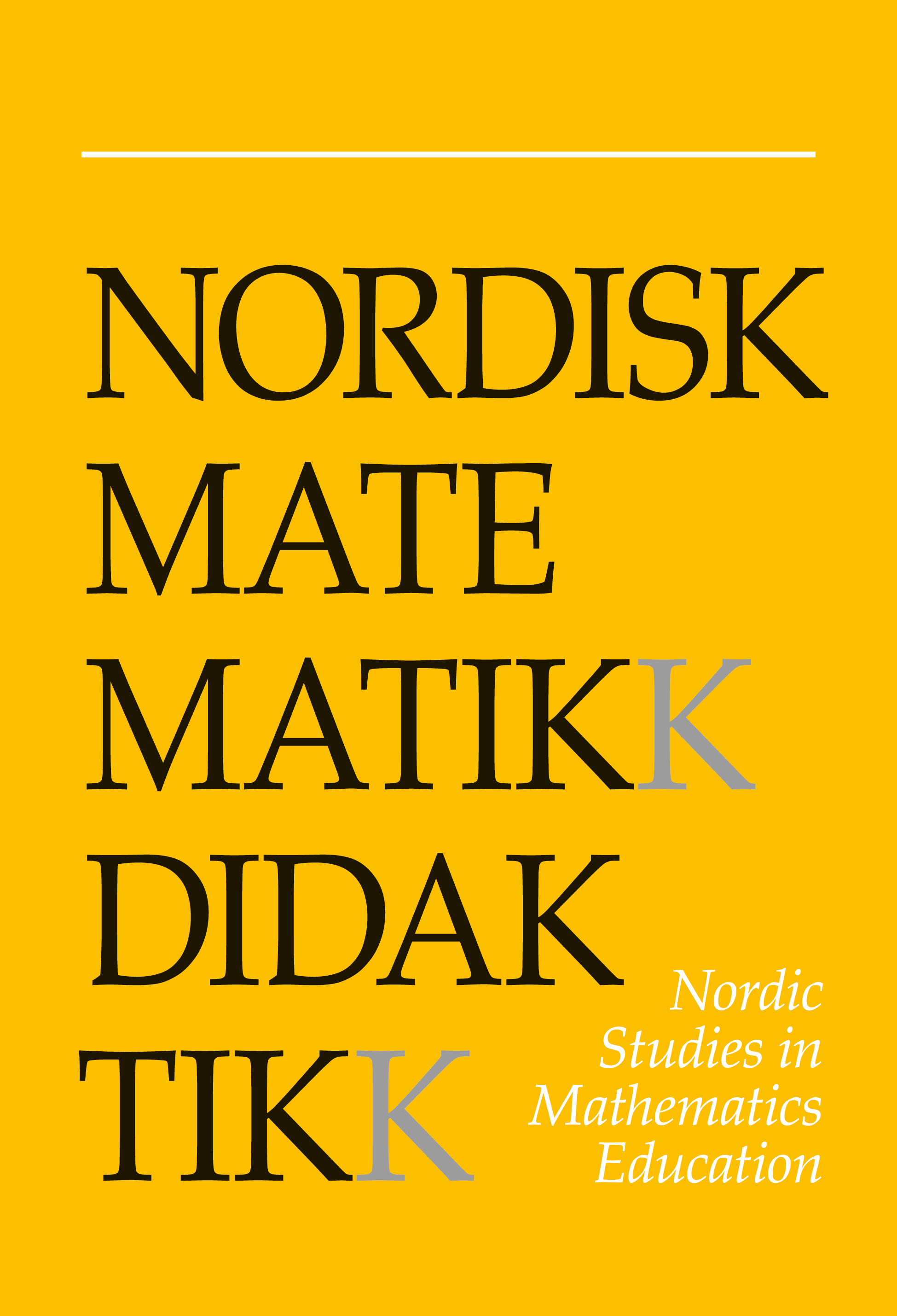Teachers’ participation in practice based research – a methodological retrospect
DOI:
https://doi.org/10.7146/nomad.v26i3-4.149174Abstract
The focus of this article is methodological, on how teachers’ participation in practice-based research coacts with research quality. Educational design research is an example of a practice-based research approach often used in mathematics education with the goal of developing both the theories and the practice of teaching and learning mathematics. In this article, one such educational design research study on problem solving in Swedish preschool class is used as an example of how teachers’ participation in practice-based research can develop and of how different kinds of collaboration between researchers and teachers coact with research quality. One conclusion of the methodological meta-analysis is that there is a challenging tension between ensuring external validity of a study versus enabling internal validity and improvement of practice.
References
Anderson, T. & Shattuck, J. (2012). Design-based research: a decade of progress in education research? Educational Researcher, 41 (1), 16-25. https://doi.org/10.3102/0013189X11428813
Bakker, A. (2018). Design research in education: a practical guide for early career researchers. Routledge. https://doi.org/10.4324/9780203701010
Bommel, J. van & Palmér, H. (2016). Young children exploring probability: with focus on their documentations. Nordic Studies in Mathematics Education, 21 (4), 95-114.
Bommel, J. van & Palmér, H. (2018). Enhancing young children's understanding of a combinatorial task by using a duo of digital and physical artefacts. Early Years, 1-14. https://doi.org/10.1080/09575146.2018.1501553
Borko, H. (2004). Professional development and teacher learning: mapping the terrain. Educational Researcher, 33 (8), 3-15. https://doi.org/10.3102/0013189X033008003
Cai, J. (2010). Commentary on problem solving heuristics, affect, and discrete mathematics: a representational discussion. In B. Sriraman & L. English (Eds.), Theories of mathematics education: seeking new frontiers (pp. 251-258). Springer. https://doi.org/10.1007/978-3-642-00742-2_25
Cai, J. (2019). Research pathways that connect research and practice. Journal for Research in Mathematics Education, 50 (1), 2-10. https://doi.org/10.5951/jresematheduc.50.1.0002
Cai, J., Morris, A., Hohensee, C., Hwang, S., Robison, V. & Hiebert, J. (2017a). A future vision of mathematics education research: blurring the boundaries of research and practice to address teachers' problems. Journal for Research in Mathematics Education, 48 (5), 466-473. https://doi.org/10.5951/jresematheduc.48.5.0466
Cai, J., Morris, A., Hwang, S., Hohensee, C., Robison, V. & Hiebert, J. (2017b). Improving the impact of educational research. Journal for Research in Mathematics Education, 48 (1), 2-6. https://doi.org/10.5951/jresematheduc.48.1.0002
Cai, J., Morris, A., Hohensee, C., Hwang, S., Robison, V. & Hiebert, J. (2018). Reconceptualizing the roles of researchers and teachers to bring research closer to teaching. Journal for Research in Mathematics Education, 49 (5), 514-520. https://doi.org/10.5951/jresematheduc.49.5.0514
Cobb, P. & Gravemeijer, K. (2008). Experimenting to support and understand learning processes. In A. E. Kelly, R. A. Lesh & J. Y. Baek (Eds.), Handbook of design research methods in education: innovations in science, technology, engineering, and mathematics learning and teaching (pp. 68-95). Routledge.
Grundén, H. (2017). Diversity in meanings as an issue in research interviews. In A. Chronaki (Ed.), Mathematics education and life at times of crises: proceedings of MES 9 conference (Vol. 2, pp. 503-512). University of Thessaly.
Hiebert, J. & Grouws, D. A. (2002). The effects of classroom mathematics teaching on students learning. In F. K. Lester (Ed.), Second handbook of research on mathematics teaching and learning (pp. 371-404). NCTM & Information Age.
Kilpatrick, J. (1993). Beyond face value: assessing research in mathematics education. In G. Nissen & M. Blomhøj (Eds.), Criteria for scientific quality and relevance in the didactics of mathematics (pp. 15-34). Danish Research Council for the Humanities.
Lerman, S. (2000). The social turn in mathematics education research. In J. Boaler (Ed.), Multiple perspectives on mathematics teaching and learning (pp. 19-44). Greenwood Publishing. https://doi.org/10.5040/9798400688362.0005
Lesh, R. & Zawojewski, J. (2007). Problem solving and modeling. In F. K. Lester (Ed.), Second handbook of research on mathematics teaching and learning (pp. 763-799). NCTM & Information Age.
McKenney, S. & Reeves, T. (2014). Educational design research. In J. M. Spector, M. D. Merrill, J. Elen & M. J. Bishop (Eds.), Handbook of research on educational communications technology (pp. 131-140). Springer. https://doi.org/10.1007/978-1-4614-3185-5_11
National Agency for Education (2014). Preschool class: assignment, content and quality. Swedish National Agency for Education.
Niss, M. A. (2018). The very multi-faceted nature of mathematics education research. In E. Bergqvist, M. Österholm, C. Granberg & L. Sumpter (Eds.), Proceedings of PME 42 (Vol. 1, pp. 35-50). Umeå University.
Patton, M. Q. (2002). Qualitative research & evaluation methods. Sage.
Palmér, H. & Bommel, J. van (2018a). Problem solving in early mathematics teaching: a way to promote creativity? Creative Education, 9, 1775-1793. https://doi.org/10.4236/ce.2018.912129
Palmér, H. & Bommel, J. van (2018b). Young students' feelings towards problem solving tasks: What does "success" imply? In B. Rott, G. Törner, J. Peters-Dasdemir, A. Möller & Safrudiannur (Eds.), Views and beliefs in mathematics education (pp. 69-78). Springer. https://doi.org/10.1007/978-3-030-01273-1
Palmér, H. & Bommel, J. van (2020). Young students posing problem-solving tasks: What does posing a similar task imply to students? ZDM, 52 (4), 743- 752. https://doi.org/10.1007/s11858-020-01129-x
Peressini, D., Borko, H., Romagnano, L., Knuth, E. & Willis, C. A. (2004). Conceptual framework for learning to teach secondary mathematics: a situative perspective. Educational Studies in Mathematics, 56 (1), 67-96. https://doi.org/10.1023/B:EDUC.0000028398.80108.87
Prediger, S., Gravemeijer, K. & Confrey, J. (2015). Design research with a focus on learning processes: an overview on achievements and challenges. ZDM, 47 (6), 877-891. https://doi.org/10.1007/s11858-015-0722-3
Scheiner T. (2019). If we want to get ahead, we should transcend dualisms and foster paradigm pluralism. In G. Kaiser & N. Presmeg (Eds.), Compendium for early career researchers in mathematics education. Springer. https://doi.org/10.1007/978-3-030-15636-7_27
Sierpinska, A. (1993). Criteria for scientific quality and relevance in the didactics of mathematics. In G. Nissen & M. Blomhøj (Eds.), Criteria for scientific quality and relevance in the didactics of mathematics (pp. 35-74). Danish Research Council for the Humanities.
Stake, R. E. (1995). The art of case study research. Sage.
Swedish Research Council (2017). Good custom in research. Vetenskapsrådet.
Downloads
Published
How to Cite
Issue
Section
License

This work is licensed under a Creative Commons Attribution-NonCommercial-ShareAlike 4.0 International License.



